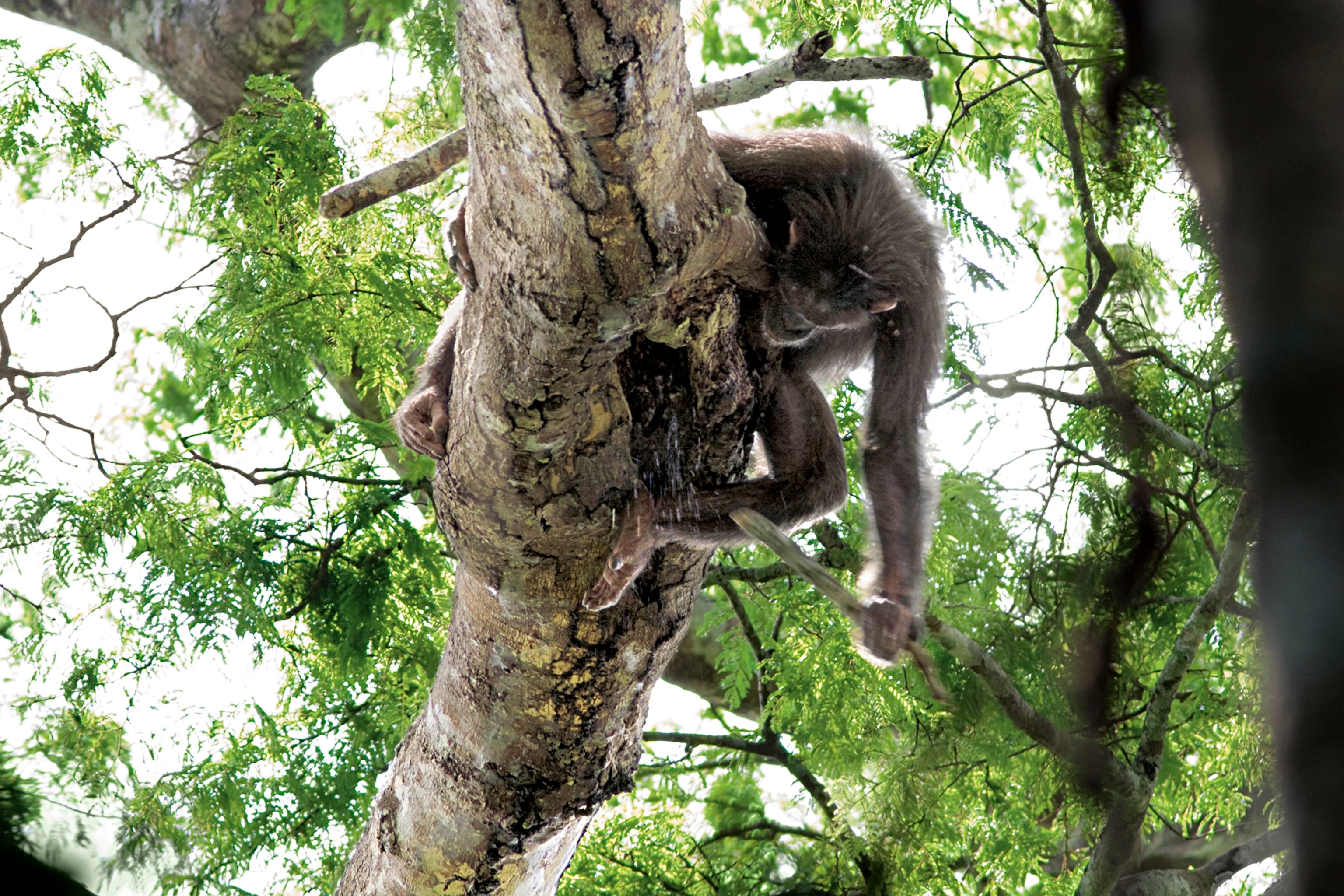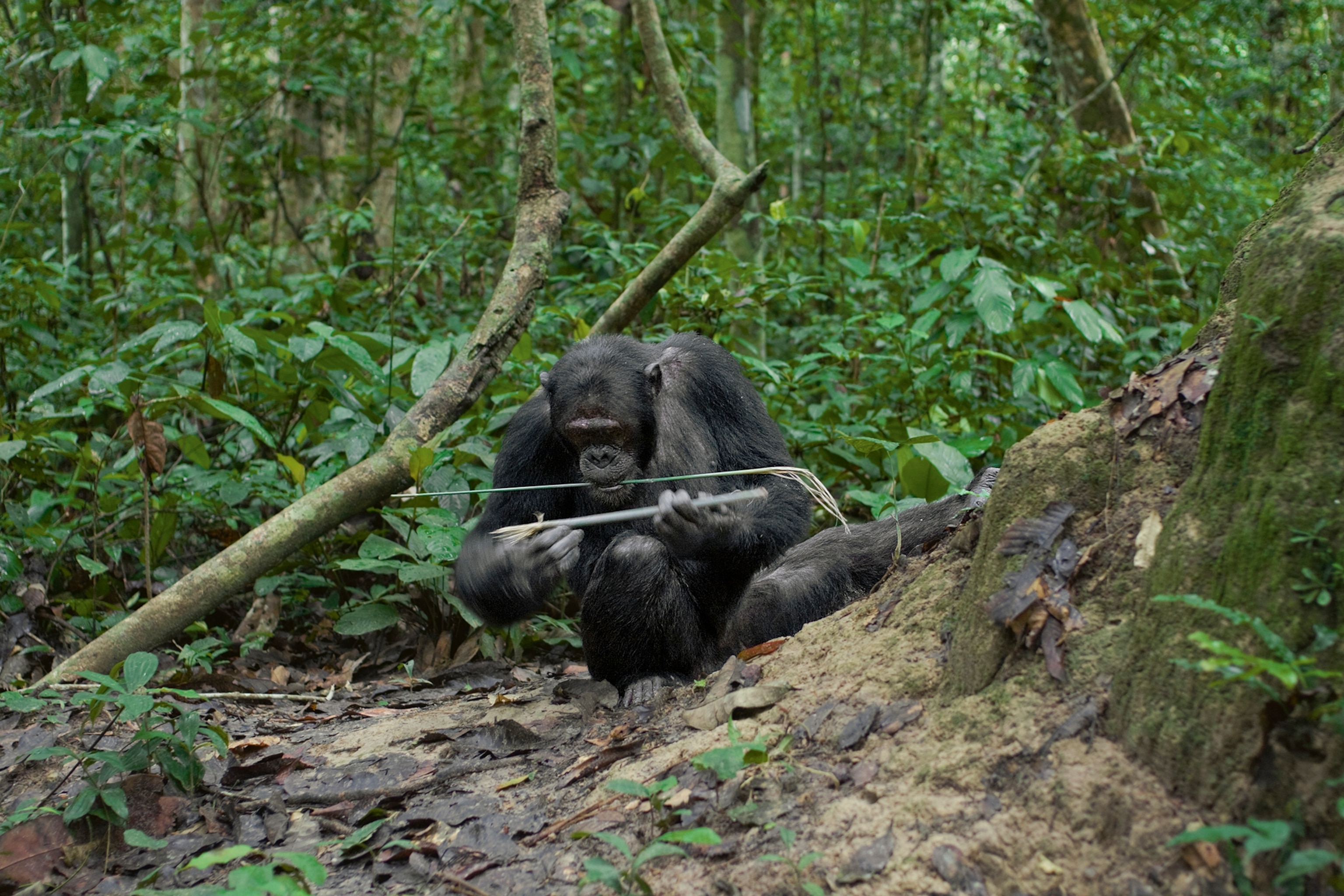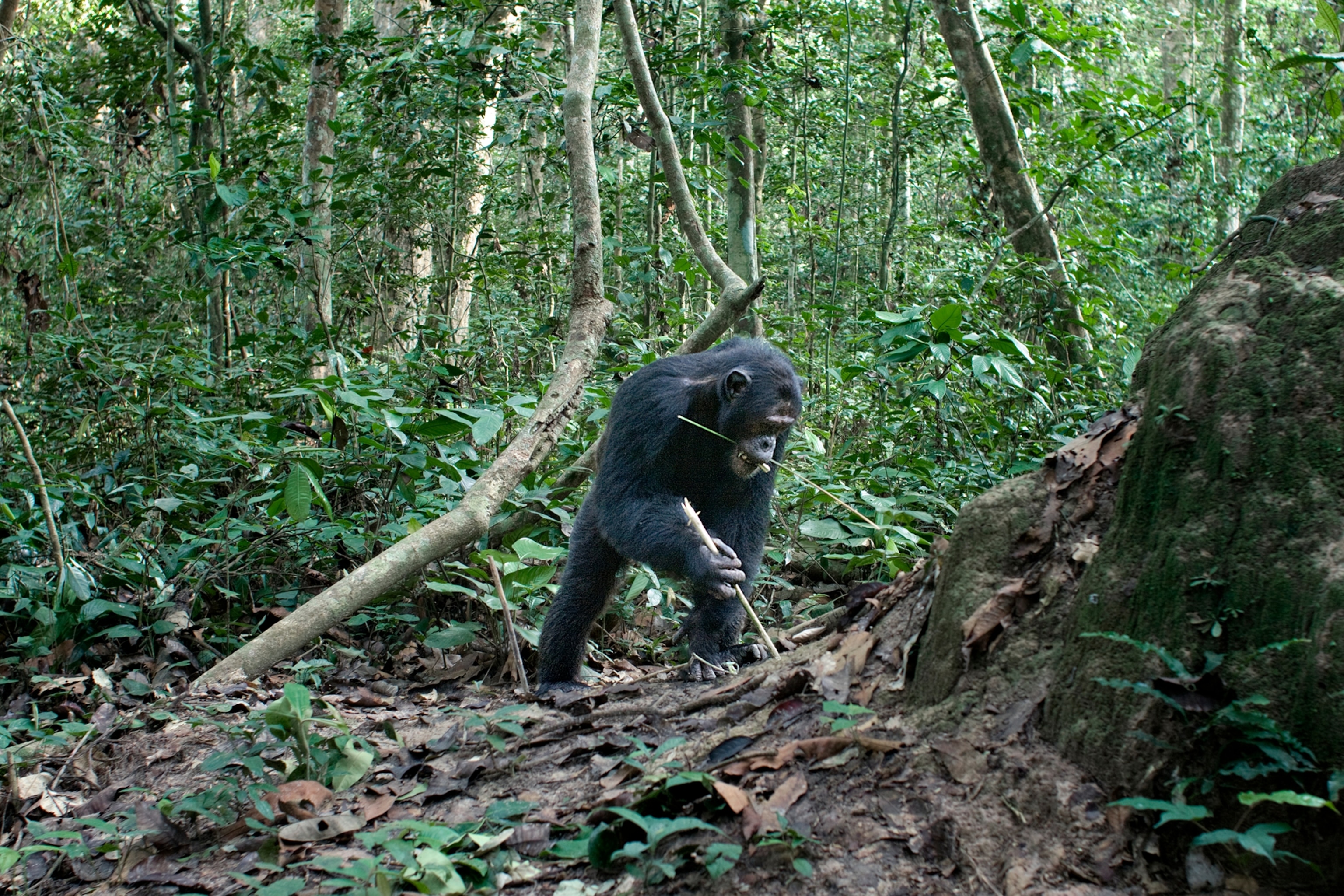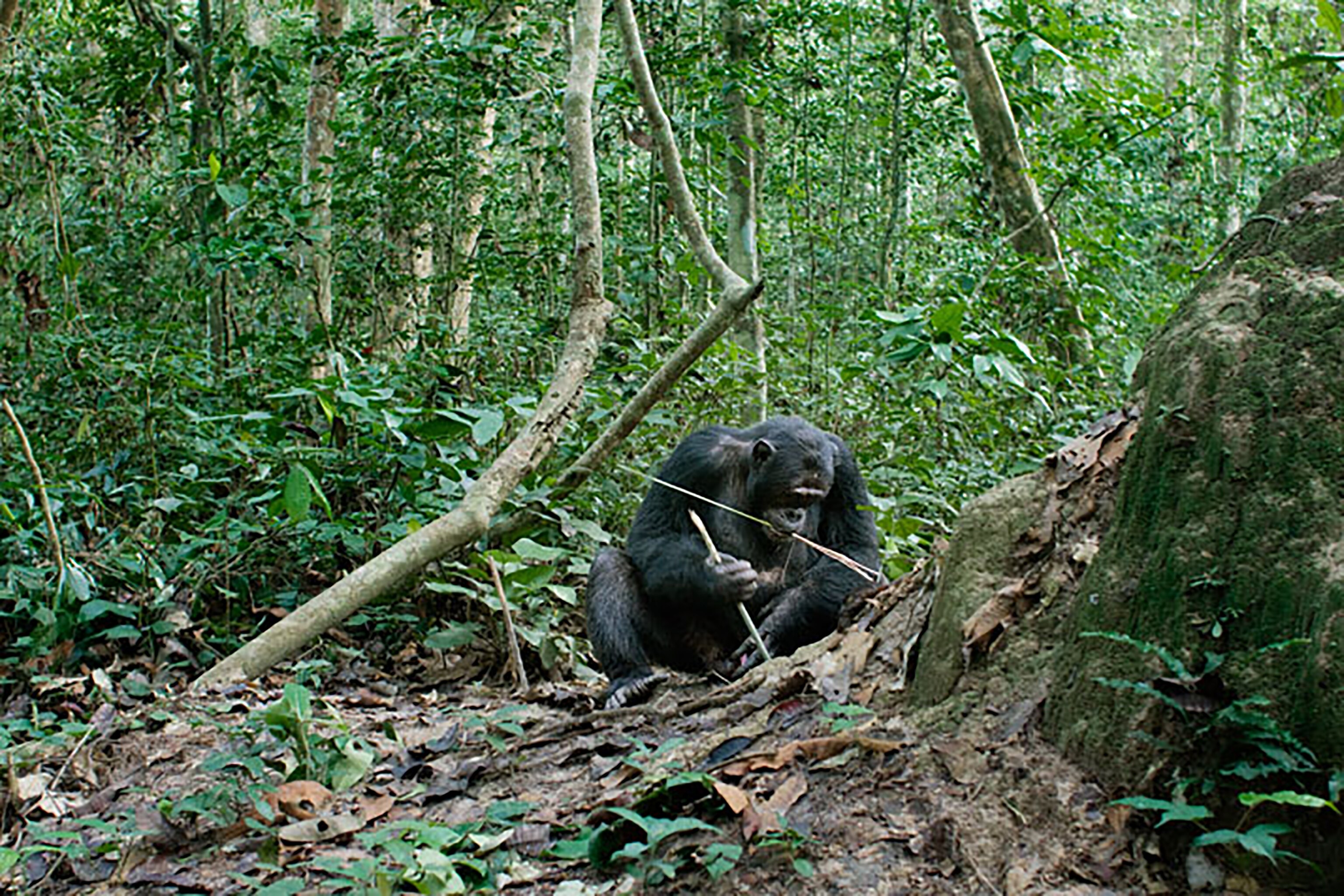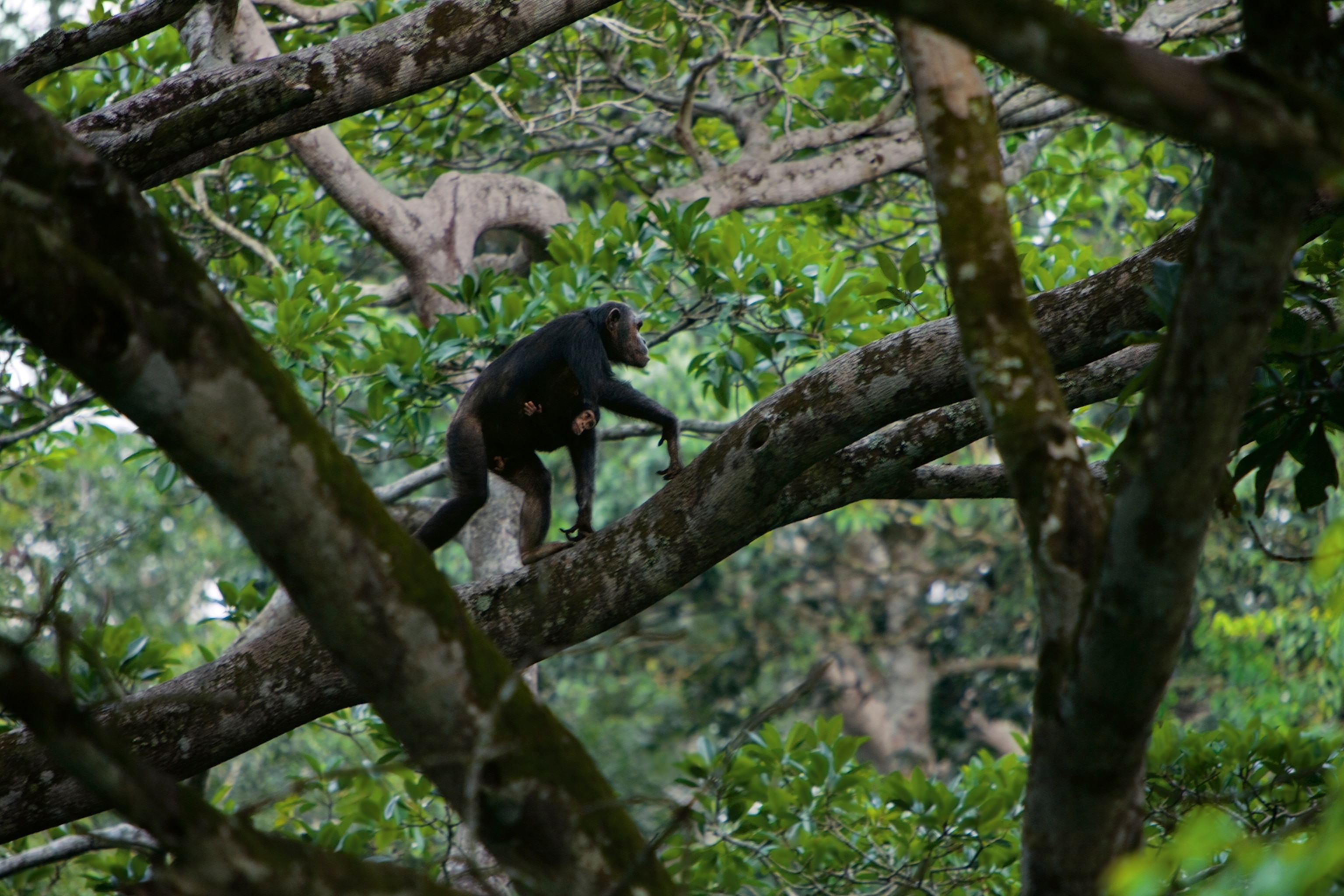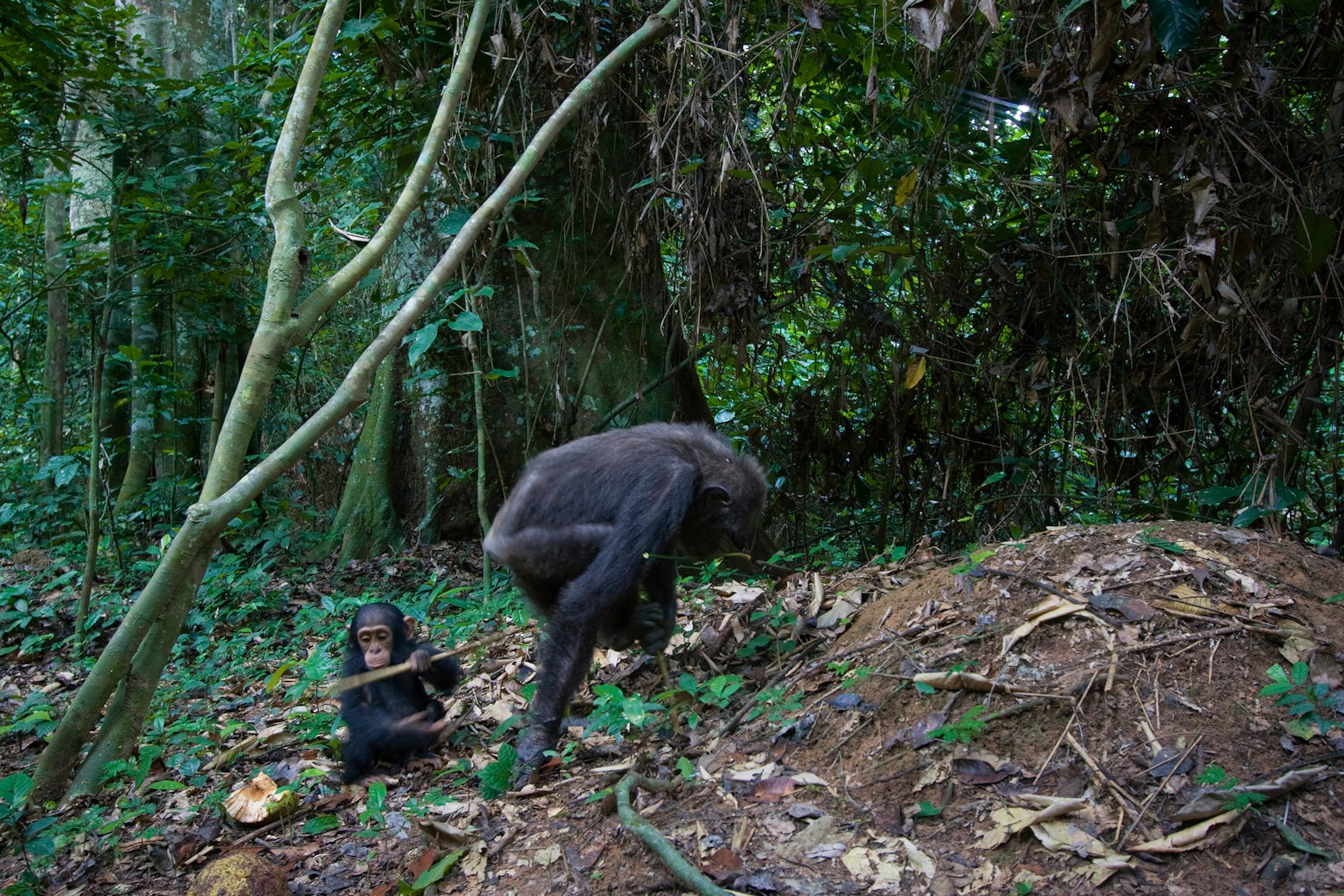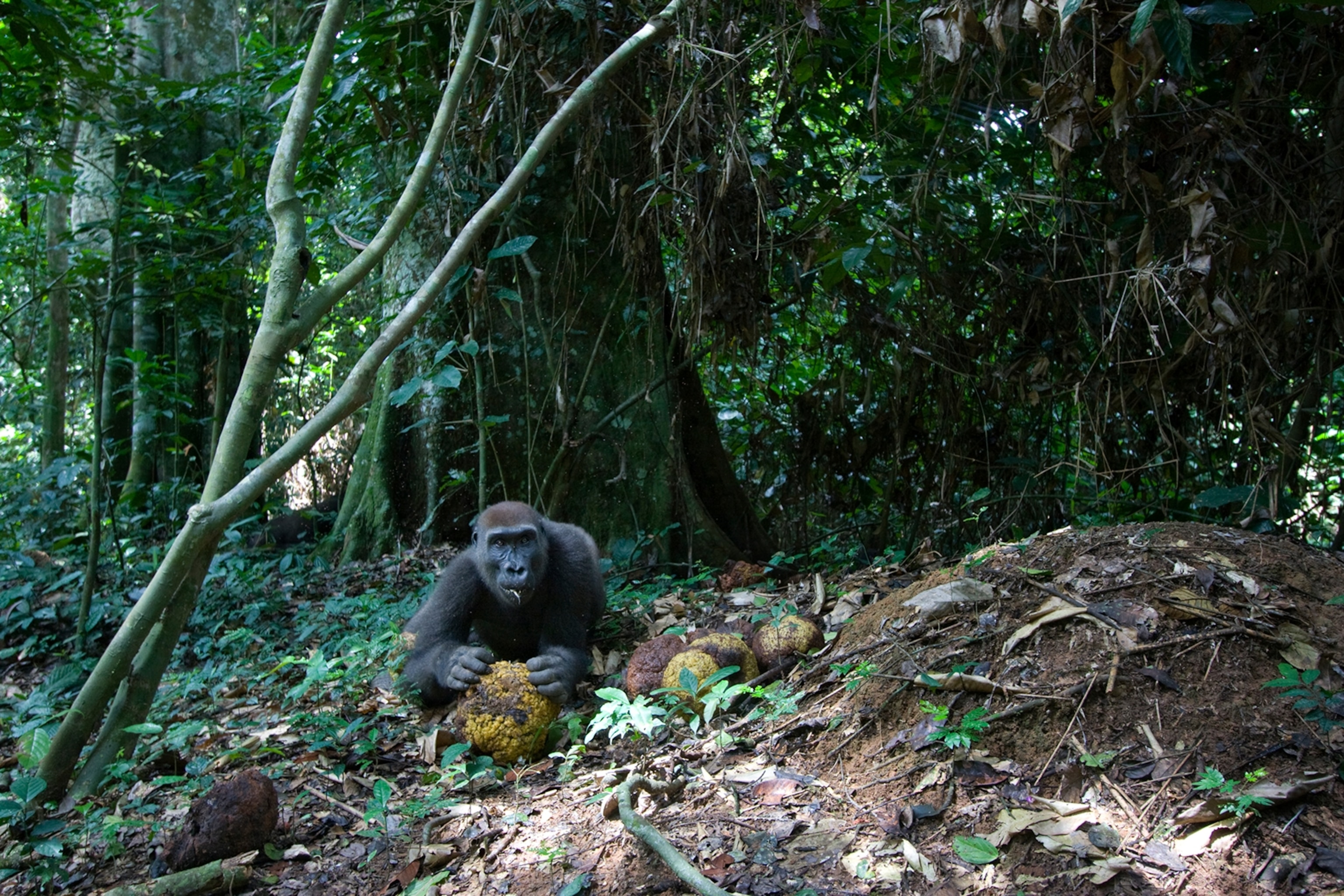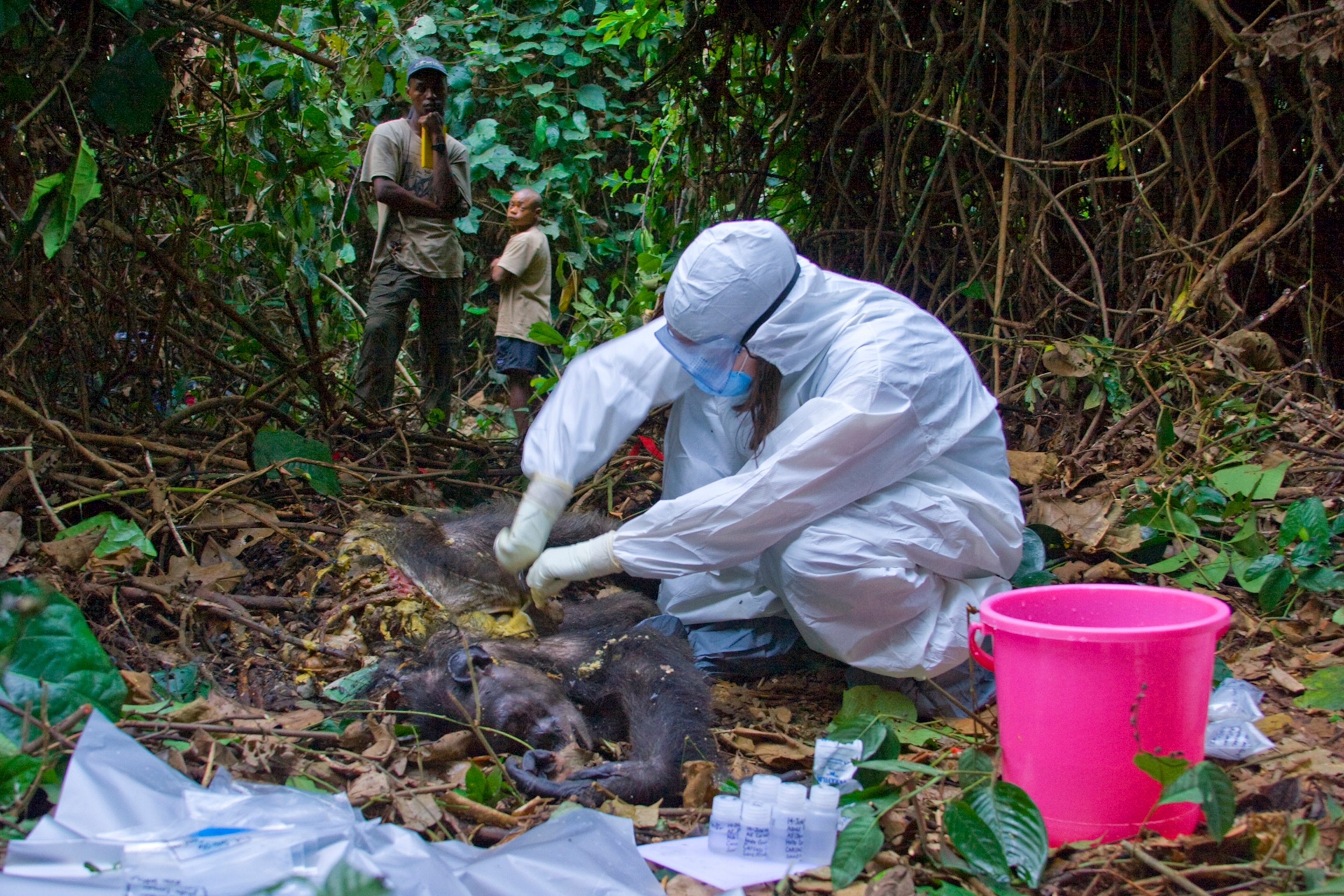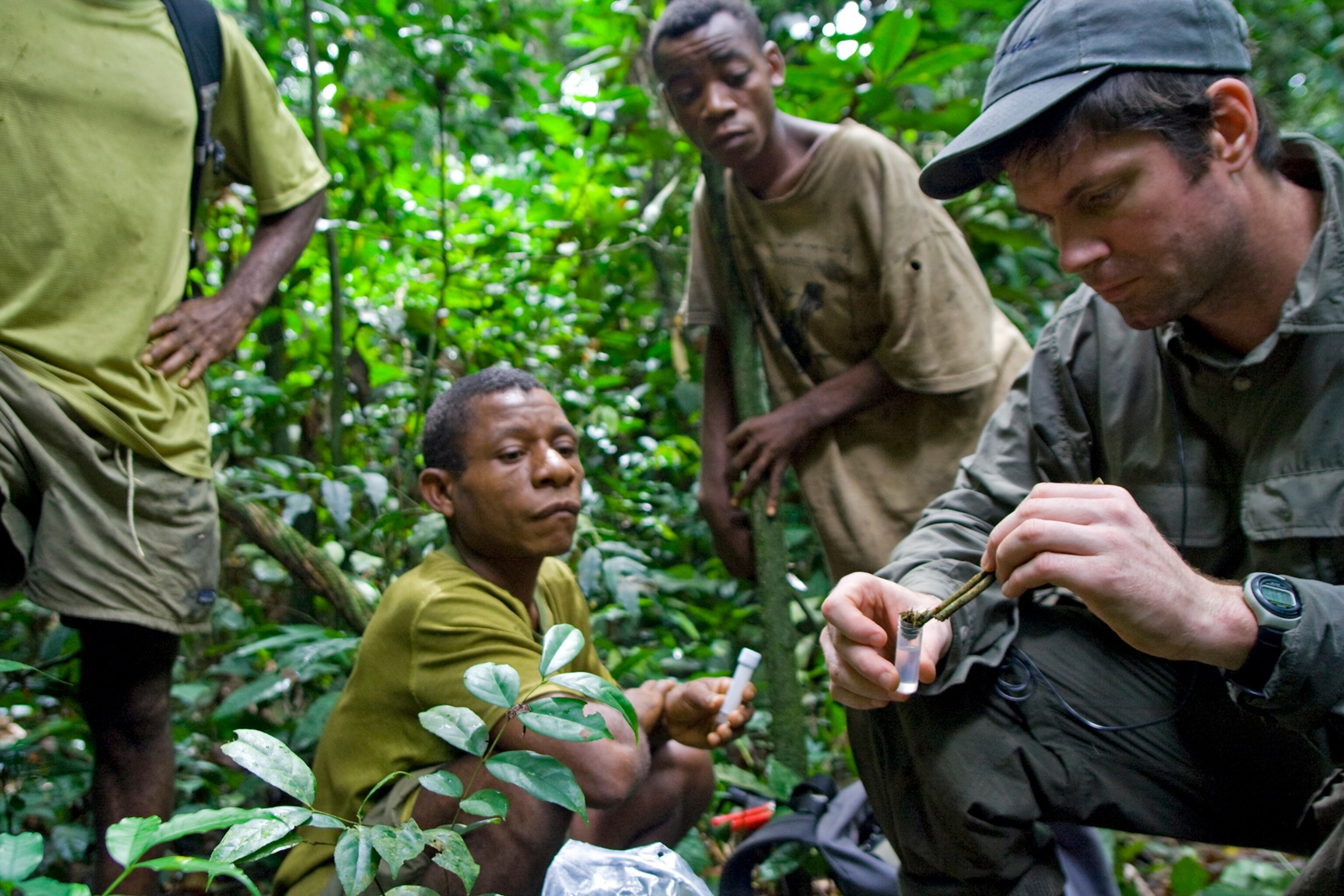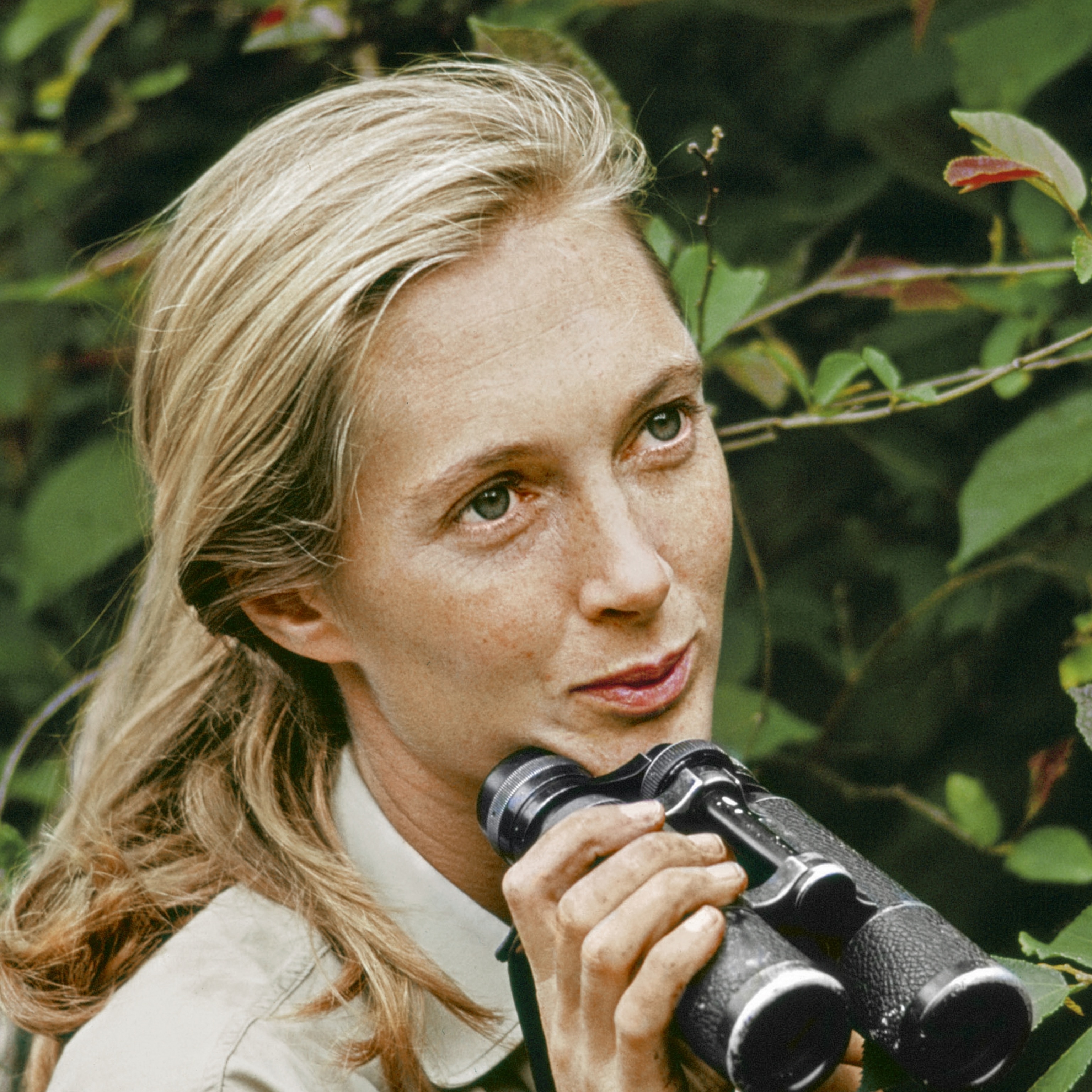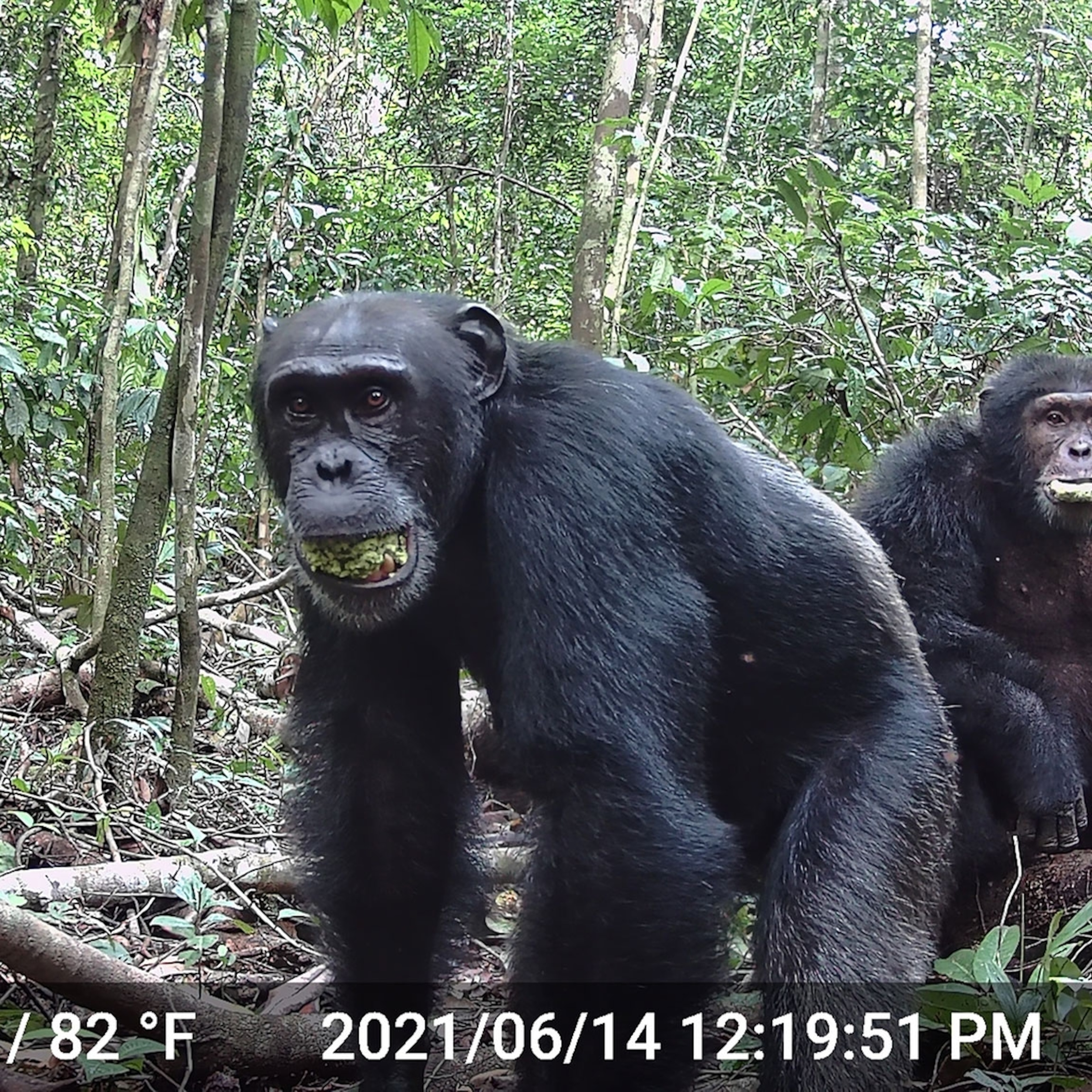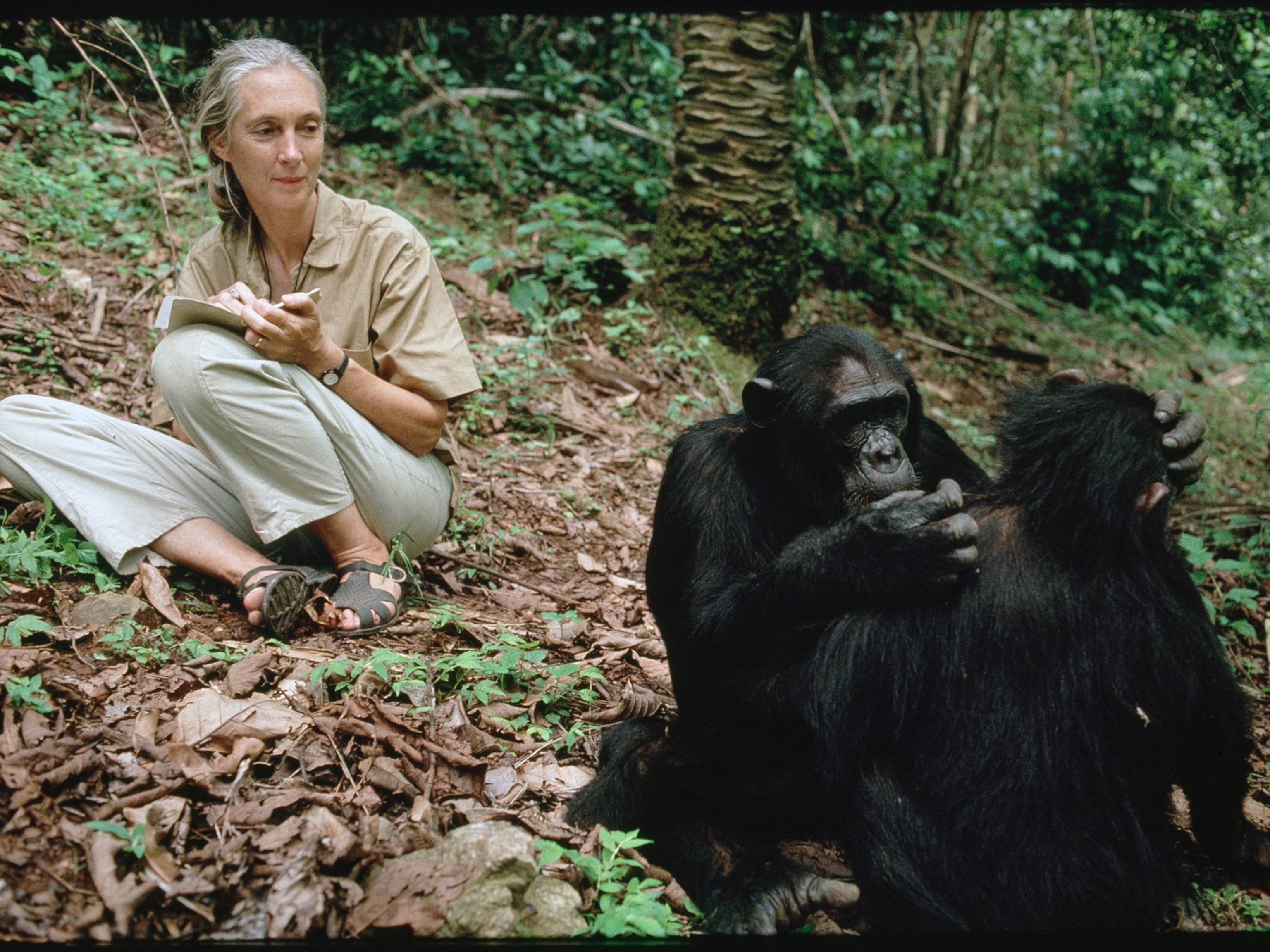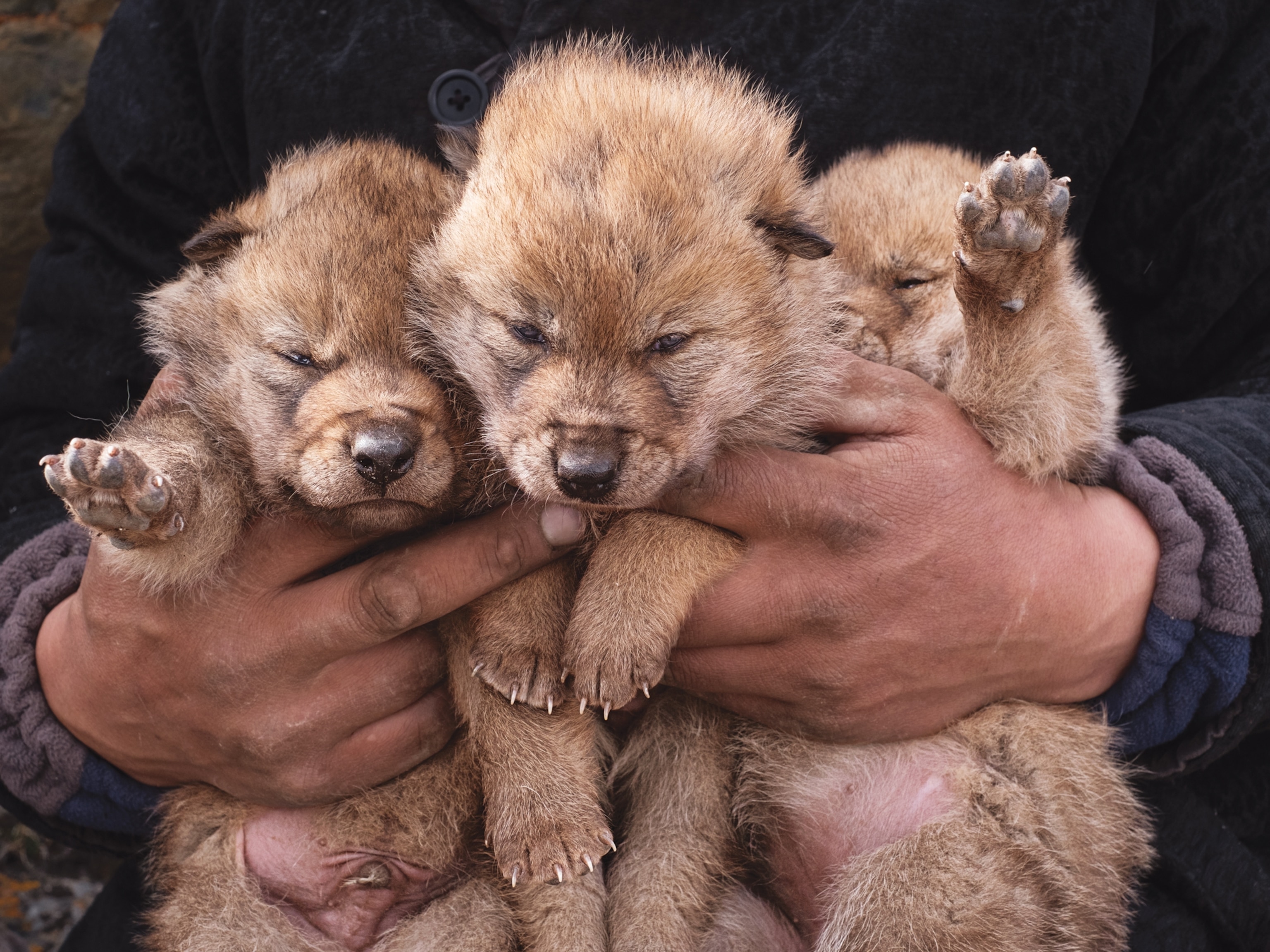The Truth About Chimps
Virtually innocent of human contact, the chimps of Congo's Goualougo Triangle display a sharp curiosity about us—and a sophisticated culture of toolmaking observed nowhere else.
A few years ago, while setting up camp deep in the Congolese rain forest, Dave Morgan and Crickette Sanz heard a party of male chimpanzees vocalizing raucously in the distance. The hoots grew louder, and they could tell the group was moving rapidly through the canopy.
The chimps, they realized, were headed straight for their camp and would soon be nearly on top of them. Then, just as the group seemed to be closing its distance to a few dozen yards, the forest went silent. A few seconds passed before Sanz and Morgan heard a gentle hoo from a tree almost directly above them. They looked up and saw a perplexed adult chimp peering down.
When wild chimps encounter humans, they typically flee in panic—understandable given that the relationship between our two species has often been one of prey and predator. This reticence around humans is part of what makes wild chimp research so difficult. Before the animals can ever be studied, they must learn not to bolt at the sight of a person, a process of habituation that requires many years of diligently trailing the animals around the forest.
One thing unhabituated chimps aren't ever expected to do when they run into humans is call over all their buddies. But that's exactly what happened. Another chimp showed up a moment later. Then a third. Then a fourth. Manic yelping enveloped the canopy. Morgan and Sanz may have been the scientists, but it was the chimps who were behaving as if they'd made some great discovery. The party sat on limbs above the camp all evening, watching excitedly as a fire was started, tents were pitched, and dinner was prepared.
"I thought, This is what loggers must have seen all through central Africa, and poachers shot them all," says Morgan, 40, a conservation fellow with Lincoln Park Zoo and the Wildlife Conservation Society (WCS). Morgan has spent the better part of the past ten years living with Sanz in the Goualougo Triangle study area, a pristine 147-square-mile nub of lowland forest overlapping the Ndoki and Goualougo Rivers in northern Republic of the Congo. He and Sanz were awed by the close encounter, but they began to wonder when it might end. It was getting dark. Where were the chimps going to nest?
"Sure enough, they built their nests directly over our tents," says Morgan. "I was like, This is great! But our trackers were like, No way, man, this is very bad news." All night long, the chimps hollered from the trees, shook branches, urinated and defecated on the tents, and hurled sticks at the team. Nobody slept. At daybreak the chimps came down from their perches and watched from the forest floor as the group built up the fire and made breakfast. Then, quietly, one by one, the chimps slunk away and vanished into the thick underbrush.
When tales of the "curious" chimps of northern Congo—uncorrupted by misdealings with humans and apparently fully ignorant of our existence—were first reported in this magazine in 1995, more than a few primatologists scoffed. "People were like, Curiosity: Hmmm, how do you define that?" says Sanz, 34, now a professor at Washington University in St. Louis. "Poor Dave, when he first told me about these chimps, even I didn't believe him." Though there had long been scattered anecdotes of fearless central African apes who trailed explorers around the jungle and behaved as if they'd never seen a human before, it beggared belief that there could be an entire forest full of them.
Yet the Goualougo Triangle and the vast, uninhabited Nouabalé-Ndoki National Park, of which the Goualougo is a part, are so remote and inaccessible that they have remained virtually untouched by humanity. The nearest settlement, a 400-person Bantu-Bangombé Pygmy village called Bomassa, is a 30-mile trek away. There are no poachers here, no loggers, nobody even wandering through. The only people a chimp in the Goualougo might ever have a chance of crossing paths with are Morgan, Sanz, and members of their small team.
Originally WCS, which co-manages two of Congo's national parks with the Congolese government, had hoped to leave the Goualougo Triangle completely untouched as a kind of preserve within the preserve, off-limits even to the corrupting influence of science. But that calculation changed during Congo's 1997 civil war, when Congolaise Industrielle des Bois (CIB), the forestry company with logging rights in the neighboring Kabo concession, built a levee for transporting lumber across the Ndoki River a few miles south of its confluence with the Goualougo. Since CIB would soon be brushing up against the triangle's natural borders, WCS felt that it was critical to put some boots on the ground. "We had to beat the logging companies in here," says Morgan. In 1999 he hiked out to the Goualougo with a single Congolese assistant and set up one of the most remote great ape research sites in the world.
That Morgan was able to persevere out in the middle of nowhere, with spartan accommodations and minimal logistical support, had a lot to do with Sanz, who came out to the Goualougo in 2001 and has been his partner in both science and life ever since.
When I visited the triangle in 2008, I wanted to see what had become of this Eden and its supposedly guileless inhabitants. The Goualougo remains a primate wonderland, with an astounding density of both gorillas and chimps. Things that haven't been observed anywhere else in Africa happen here—and often. Morgan and Sanz have watched chimps and gorillas nibble on fruit in the very same tree. (Not quite the lion lying down with the lamb, but for primatologists, just as bizarre.) They've seen chimps cup their hands and beat their chests, as if mimicking their gorilla neighbors. But the most spectacular finding to come out of the Goualougo over the past several years is an expanded view of what can only be called chimp culture, a tradition of using complex "tool kits." After a decade of determined study by Morgan and Sanz, the story of the Goualougo is no longer how little the chimps know of us, but rather how much we now know of them.
On a sticky September morning at the front end of the Congo’s rainy season, Morgan, Sanz, and I leave the Goualougo base camp at dawn with our tracker Bosco Mangoussou and begin marching down one of the well-worn elephant trails carved into the forest. The sun has barely broken through the canopy, but already swarms of stingless Meliponini sweat bees are clinging to any piece of exposed flesh not coated with menthol balm. Our route regularly slaloms around patties of elephant dung and heaps of rotting fruit, whose pungent aromas permeate the humid air. It is the immense variety of those fruits—more than two dozen edible species ranging from pumpkin-size Treculia africana to rubbery, soft ball-size Chrysophyllum lacourtiana—that makes the Goualougo such an attractive habitat for chimps. Our destination this morning is the primary range of the Moto community, one of 14 distinct chimp groups that call the Goualougo Triangle home.
Periodically the sound of a distant pant-hoot pierces the forest. When that happens, Morgan sets the bearings on his compass and we tear off on a sprint through prickly brambles and knobby lianas. Mangoussou, a Babenzélé Pygmy who stands barely five feet tall and has a mouthful of teeth chiseled to sharp points, leads the way, sometimes slowing to clip a path through the understory with a pair of gardening shears. After one five-minute dash, we spot a half dozen chimps lounging in an Entandrophragma tree about 130 feet off the ground.
We watch through binoculars as a puckish subadult female, a new immigrant to the Moto community, horses around with Owen, a juvenile orphan whose mother was recently killed by a leopard. With a small twig clenched between her teeth, the female (Morgan and Sanz later generously named her Dinah, after my wife) chases after Owen and wrestles him onto a nearby limb. Then something remarkable happens that has almost never been observed outside of the Goualougo.
Dinah spies a cloud of sweat bees emerging from a hole near the main trunk of the tree. She leaps to her feet, leaves Owen behind, and breaks off a branch about as thick and long as a human arm. With the blunt end she begins whaling away at the bark. She knows that somewhere inside a hard-to-access crevice is a hive with a small cache of honey.
Dinah's rhythmic thumping echoes loudly off the surrounding trees. She transfers the club to her foot and swings around to the other side of the trunk to get a better angle. Then she rips a small twig off a nearby branch, dips it into the hive, and swirls it around like a knife at the bottom of a peanut butter jar. She pulls it out, sniffs it, realizes there's no honey on it, throws it away, and starts pounding some more. She repeats the process, running through seven different dipping sticks. Finally, after nearly 12 minutes of hammering at the disobliging hive, she plunges her finger into a crack and seems to yank out the slightest bit of honey, which goes straight into her mouth. But just as she is beginning to enjoy the fruits of her labor, Finn, the Moto community's alpha male and resident bully, descends from a nearby branch with his hair standing on end, seemingly outraged that a young upstart is enjoying a sugary delicacy in his presence. He lunges at Dinah, who drops her club and flees to another limb. Morgan and Sanz exchange high fives. "That's one of the best honey-pounding observations anyone has ever had!" Sanz exclaims gleefully.
The fact that honey pounding hasn't been observed at other chimp research sites outside of central Africa suggests that it is not part of the species' innate behavioral repertoire, but rather is a learned skill that has been culturally transmitted. Part of what makes Dinah's behavior so intriguing is that she used two different kinds of tools—a big club and a thin twig—in sequence to accomplish her goal.
This isn't the only form of serial tool use common in the Goualougo. At the exact moment that we are watching Dinah attack the beehive, a camera trap set up near a termite mound half a mile away records another female chimp named Maya, a matron of the Moto community, engaging in what may be the most sophisticated form of serial tool use by any nonhuman animal.
Maya arrives at the termite mound, a rock-hard, bulbous structure three times her height, carrying in her mouth several plant stems that she will use to fish out its high-calorie occupants. First she rams a thick twig into a termite hole and widens it by jiggling the stick vigorously. Then she grabs a thin, flexible stem that she plucked off a nearby Sarcophrynium plant. Chimps in other parts of Africa are known to fish for termites with implements like this, but Maya goes one step further and modifies the tool. She drags the last six inches of the stem through her teeth to create a wet, frayed end, like a paintbrush, and pulls it through her closed fist to straighten out the bristles. With the dexterity of a professional lock picker, she then threads the brush-tipped stem into the same hole, pulls it out, and nibbles off a couple bugs that cling to the wand's frayed edges.
What's so remarkable about that fishing probe is that it represents a refinement. It's not just that some clever chimp figured out that it could break off a plant stem and use it to fish for termites—an impressive enough discovery in its own right—it's that some other chimp figured out a way to do it even better. And the brush tip is not merely a trivial upgrade. Morgan and Sanz have tried termite fishing themselves with both brush-tipped and unmodified sticks and found that they picked up ten times more termites with the frayed tool. Without a time machine, we'll never know how human culture began, but it must have looked something like this: one simple discovery building on another.
"The Goualougo is probably the only place on Earth where humans will ever have the chance to see what chimpanzee culture is really about," says J. Michael Fay, the WCS conservationist who helped set up the Nouabalé-Ndoki Park. "Ninety-five percent of chimps on Earth don't live like this because of humans." In the Kibale National Park and Budongo Forest Reserve, two of the most important chimp study sites in Uganda, about a quarter of the population has snare wounds. At Gombe, the site in Tanzania pioneered by Jane Goodall, there are only about a hundred chimps left, and they are surrounded by humans.
This is a powerful and troubling notion: What if everywhere scientists have thought they were observing chimps in their natural state, they've actually been studying behavior distorted by the presence of humans?
Chimps are highly adaptive creatures. They can get along just as well in the forests of Congo as on the dry savanna fringes of Senegal. But according to the fragile-cultures hypothesis, first proposed by the Dutch primatologist Carel van Schaik, we may be radically underestimating just how fragile chimp culture is. Humans don't necessarily have to be clear-cutting forests for our presence to distort primate behavior. Even selective logging and casual hunting can throw chimp society into disarray if it pushes groups into conflict or decreases the number of termite mounds where they can fish.
Morgan and Sanz have put forth a powerful hypothesis: With fewer mounds and, therefore, fewer opportunities for young chimps to learn tool techniques from their elders, chimp culture may slowly attenuate, and complex learned behaviors may disappear. The pair will soon have an opportunity to test their hypothesis. In the next few years, CIB will probably begin logging operations in a sector of forest just east of the Goualougo River dubbed Zone C. In anticipation, the research team has been conducting rigorous line-transect studies in Zone C since 2002 in order to get a clear before-and-after picture of how logging affects chimp behavior.
Zone D, an area west of the triangle that CIB began logging five years ago, offers a preview of what might happen in Zone C. "This was beautiful forest in 2004," says Morgan dolefully, as we step from our pirogues onto the dry land of Zone D. It is clear that we've entered an entirely different environment. We cross muddy logging road after muddy logging road, some as wide as a two-lane boulevard, lined with upturned roots and rotting offcuts.
CIB's logging operation meets the logging industry's most demanding standards for sustainability and environmental responsibility. "They're the best logging company in central Africa," says Paul Telfer, head of the WCS Congo program. "I'd prefer no logging at all, but if you're going to have a logging company next to a park, you'd want it to be CIB."
Still, the landscape has been selectively ravaged, and the chimps are nowhere to be found. Just six years ago, the apes that Morgan and Sanz found in Zone D were mostly naive. Now when they catch wind of humans, they hide or flee. They've learned to fear us.
Most of the 400-odd chimps that Morgan and Sanz have encountered in the Goualougo no longer display the same sense of curiosity they once did. The more time the researchers spend there, and the more they demystify the wonders of this primal forest, the rarer their naive encounters have become. To study and conserve these chimps inevitably means changing them.
Yet the triangle is just one small corner of a vast, virtually unexplored forest. Before leaving the Goualougo, I trek out to its very southern tip with Morgan and Sanz to spend two nights camping in the home range of the Mayele community, near the juncture of the Goualougo and Ndoki Rivers. Here, in a part of the forest that Morgan and Sanz only occasionally visit, we encounter a naive chimp.
As soon as he sees us, he begins screaming hysterically, ducking between branches to get a better look. Morgan puts down his backpack and quietly pulls out a spotting scope, the kind that a hunter might use to pick off a deer from 300 yards, and uses it to get a closer look. "That chimpanzee has never seen a human before," he tells me.
The young male whips a liana around violently in a display of youthful bluster, then hurls a few sticks in our direction to see how we'll respond. Before long, his calls attract others, and a total of seven chimps join him on the limbs above us, all raptly watching the hairless, upright apes on the forest floor. We might as well be from outer space.
Cautiously, and without averting their gazes, the chimps inch ever nearer to us until finally the youngest one is sitting on a branch not ten yards away. Sanz hands us each a surgical mask—to protect the chimp, not us.
"Talk about maladaptive behavior," Morgan whispers, with a chuckle. We back off a bit and spend the next several hours with our eyes locked on theirs: Us watching them watch us watch them. Eventually we have to move on. There's more forest to explore, more chimps to find. Our curiosity gives out before theirs does.

